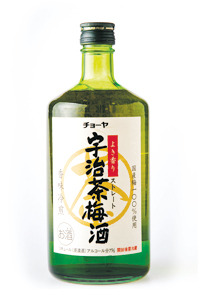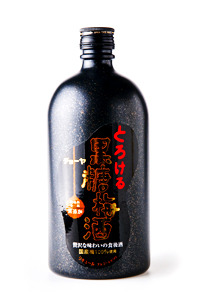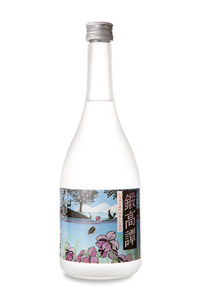Japanese English
He will never speak enough once the sake cocktail topic starts

[Profile]
The bar manager and mixologist (bartender) of “Little Red Pocket”, a Japanese Tapas Bar in the City. He also introduced the innovative table-mounted ipad ordering system into the store.
— Please tell us the background as to why there are many different types of Japanese sake used in Little Red Pocket.
It has been decided to use Japanese sake when the bar first opened in August, 2011 but I had absolutely no idea of sake, except they are made from rice. Lucky for me to get some sake knowledge from a friend who ran a contemporary Japanese restaurant. He also helped me with the initial list.
I have been to tequila distilleries in Mexico, gin and scotch distilleries in Britain and Scotland, a *pisco distillery in Peru and of course, I have been to a lot of wineries so I understand how those are brewed and I have an extensive knowledge on alcohol. I have also done a lot of training on alcohol-distilling, wine-making and blending.
*Pisco
A light amber coloured, distilled alcohol (brandy) made of grapes produced in Peru. An alcohol content of 42%.

It is essential to learn the processes of sake and know sake to a certain level. I had Sake Master Toshi from Maedaya (Japanese Izakaya in Melbourne) come in to a training section. I learnt about the processes, different types of rice and koji molds. I now understand a lot about the products, the different flavour profiles, like the tastes and aromas.
There are still many people here in Australia who don’t know about nor have tried Japanese sake before. Those who go to Japanese restaurants might know something about sake, but a majority of people who come to Little Red Pocket know absolutely nothing. The easiest way to explain sake to them is by “Sake Cocktail”.

We structured our wine list a little differently and started off with only 12 drinks. That way people think of sake as one of the alcoholic drinks, thus be more acceptive. Some of the sakes are very expensive, for example a 12 year old Yamazaki Whisky. But making it into a cocktail means people can enjoy sake at a more reasonable price. 90% of our drinks are shochu or umeshu based and we pretty much targeted towards females as they account for 70% of the cocktail market.
|
(Please click on the sake images for details) |
|
— How umeshu (plum wine) is used for instance?
Speaking of Uji Green Tea Umeshu, there is a cocktail called “J Temple” which consists of fresh kiwi fruit, Uji Green Tea Umeshu, Japanese sake, gin, fresh squeezed lime juice and sugar syrup. It is shakened and then poured into a martini glass. A very crisp and refreshing cocktail, at the same time, very light and dry so you can taste the green tea. It works very well with kiwi fruit too.

There is another cocktail using Kokuto Umeshu with Yamazaki Whisky and raspberry. Umeshu is very sweet but it turns into a crisp and refreshing cocktail that is much easier to drink. Our customers love it because most people don’t want their cocktail overly sweet.
We have 4 different cocktails using Kokuto Umeshu. It is very popular among customers and I think it is probably one of the best products I have come across as a cocktail mixer. It is perfect!
When making new cocktails, we start off with a base ingredient like vodka, gin, bourbon, scotch and spirit; then a modifier, like liqueur. Kokuto Umeshu is phenomenal because it is mildly sweet and goes really well with berries.
|
Uji Green Tea Umeshu (Please click on the sake image for details) |
|
|
Kokuto Umeshu (Please click on the sake image for details) |
— How did you come up with new cocktails?
Well, I used to spend a lot of time. It was extremely busy when I was working at a bar in London that has 150 cocktails on the list. After my experience there, I understand how things go well and know different smells and tastes.
Just like giving a chef some ingredients and he can make a dish for you, I can do the same thing with cocktail. This is simple if you have reached a certain level. For example, I can make a cocktail even if a customer just says “I would like a cocktail like this” instead of “make me a cocktail with this”.
Ordering a cocktail is somehow similar to ordering a coffee. You have decided on what to drink when you order your coffee, like a latte with two sugar or short black no sugar, long black with half sugar etc. But with cocktail, I sometimes get requests like “I want a cocktail”. Just that. I would then ask “do you want it sweet ” or “ do you want it dry?” “do you want to taste the alcohol or do you not?”. I can then understand what he wants and come up with something.

— What are some of the sakes you like recently?
I am a big fan of the Shiso Shochu Tantakatan! It is a very good sake that I am happy to drink it on its own and I was surprised how much I love that!
The Tateyama Umeshu is great too. Although I don’t know a lot about umeshu, I think this Tateyama Umeshu is a top quality product in terms of its balance, its flavour profile and the overall complexity.
|
Tantakatan (Please click on the sake image for details) |
|
— How do people react to sake cocktails?
Some people don’t really like sake in their cocktails even they have never tried it because they don’t know how it tastes and smells like. I would explain our sake cocktails to those customers in terms of flavour, like kiwi fruit, pineapple and lime, then make them a cocktail without making the taste and the aroma of sake too prominent.
I would suggest those who want to drink sake on its own to start with ordering a small bottle. That way, you can try a little or drink something else with that sake and if you think it tastes good, you can also share it with the people who came with you.
I use Japanese sake mainly as a cocktail base. It is soft and surprisingly easy to drink, which is different from vodka or gin. A cocktail will be too sharp if I substitute sake with those as they don’t have the elegant and soft character. Japanese sake on the contrary, is light and elegant. It became so nice and easy to drink after adding lychee and rose or pineapple flavours.
From my long experience, people who order a cocktail at a bar tend not to want to taste alcohol in their drinks. I would recommend, for example, Choya Umeshu. It is good because it has a plum and apple flavour with little taste of alcohol that makes it so easy to drink.
Japanese sakes are hard to get and are still very expensive here in Australia. To many people, “sake is just the Japanese alcohol that made with rice”. Also, there are so many people choose a particular sake by the packaging or the design of the label.


–Why and how did your career as a mixologist (bartender)?
I first started when I was at university because I needed money on the weekend. I really enjoyed it and went to London after finishing my degree. I didn’t know how long I was going to be there but ended up working at a bar in London for 3 years. I realized how much more there is to know and to learn through that experience, which I truly enjoyed. I really like making drinks and working with people. It was more by accident than by choice, and then it became a choice. This is my 9th year (in 2011) in the industry.




–How did you think of so many unique names for your cocktails, such as “GINGER NINJA”and“TOKYO YOZORA”?
The most important thing is to be easy enough to pronounce. Just simple stuff to be remembered. It will be very hard to remember if the names are all in Japanese, not to mention there are words we can’t pronounce properly.
–Have you been to a sakagura (Japanese sake brewery) before? Are there any sakagura you would like to visit?
I haven’t been to Japan so I have never been to one. But there is one place to go and see in Australia if I were to visit, GO-SHU Australian Sake Brewery in Sydney. I have been all over Europe, North and South America but haven’t spent much time in Asia except for Thailand and Singapore, so I would really love to travel to Japan.


——–
* History of Cocktails
It is said that the history of cocktail dated back to the 1860s in America when the first cocktail book was written in 1860. Alcohol was brewed secretly in places such as bath tubs at that time. However, because the brewing environment was not good enough to brew good quality wine, people drank that with fruit juice in order to make it palatable. This is how cocktail was invented.
Little Red Pocket
http://www.littleredpocket.com.au/
422 Little Collins Street, Melbourne VIC 3000
TEL: (03) 9078 2051
Opening Hours: Tue-Thu 11.30am-midnights, Fri 11.30am-3am, Sat 8pm-3am







